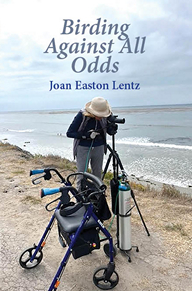One of the most fascinating habitats in the desert is the oasis. Oases originate from old underground earthquake fault lines, which allow the groundwater to bubble up to the surface. The water forms pools, streams, and springs. Plants that ordinarily require a great deal more water to flourish can be found here.
Besides the more characteristic plants — mesquite, Fremont Cottonwood, and willow–the oases are marked by groves of the large, native California Fan Palm. The immense height and shaggy fronds of these palms provide shade, and nesting and roosting places for birds seeking refuge in their fan-shaped greenery.
The greatest concentration of birds in the desert is at these oases during spring and fall migration. On any given day between mid-April and mid-May, flocks of colorful western warblers fill the palms and willows. Orange-crowned, Wilson’s, and Yellow Warblers sip from the shallow pools, flashing shades of yellow as they bathe. A Nashville, Townsend’s, Black-throated Gray, or Hermit Warbler may suddenly plummet from the sky, intent upon a moment’s rest from its arduous journey.
On this recent visit, I was disappointed to find that one of the oases at Joshua Tree National Park–Cottonwood Springs–was closed to the public. Evidently, a late summer thunderstorm in 2013 had done some damage there by bringing to the surface toxic minerals used in the mines. This desert country is riddled with old mining claims, and early prospectors had some pretty primitive ways of extracting the gold they sought.
As a result, we couldn’t visit Cottonwood Springs, which is located in the eastern portion of the Park, and at a lower elevation. This oasis, which could also be easily reached from the Palm Springs area by car, would have had more plants blooming and more bird activity, since it was around 2000 feet elevation. The higher portions of the park (elevation ~ 4000 feet) where the Joshua Trees were just beginning to sport their white, waxy blooms, was cooler. Spring comes later to this area, and desert plants were not flowering yet. Bird migration was still several weeks away.
The account in my Nature Journal from a hike I took many years ago to Forty-nine Palms Oasis describes the thrill I felt at coming upon the only natural oasis in the Park that still retains the remote quality of the desert.
( TO BE CONTINUED )

